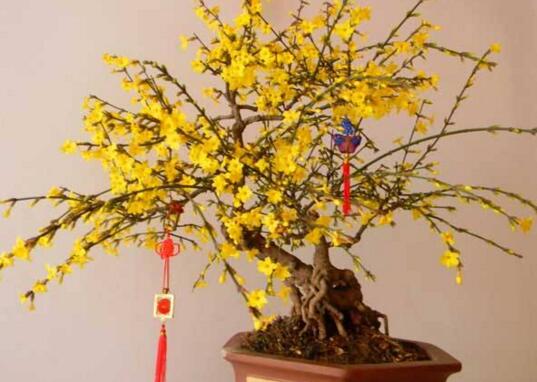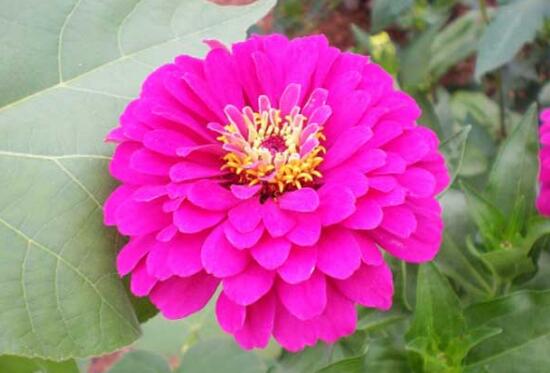What if the leaves of Lamei blossom are charred? there are four ways to make the leaves bright and dark green.
What if the leaves of Lamei blossom are scorched?

Due to the strong adaptability of Prunus mume flowers, the phenomenon of scorched leaves is relatively rare. according to statistics, the main causes of this phenomenon are lack of light, too little fertilization, too much watering, diseases and insect pests.
First, lack of light
The plum blossom likes plenty of sunshine, and only enough light can ensure that its leaves are green and shiny, and when there is a lack of light, the photosynthesis of the leaves will be weakened, resulting in a slower metabolism and charred leaves.
How to deal with it: do not put the plum blossom in a place that lacks light for a long time, if it is cultivated in the open field, you should move it to a place where there is sunlight; if it is an indoor potted plant, you should move it to a bright place, or use scattered light to make up for it.
Second, fertilization is too little.
Less fertilization includes two aspects: one is that the amount of fertilizer is not enough; the other is that the interval between fertilization is too long, and the two cases will lead to the lack of nutrition of plum flowers, and the leaves will have the same symptoms as scorching.
How to deal with it: how to deal with the charred leaves of Lamei caused by fertilization problems? Timely topdressing, but we need to pay attention to not too much fertilizer, generally 15-20 days topdressing once, usually in fertilization should be thin fertilizer frequently, the specific method we have introduced in detail in how to fertilize the plum blossom.
Third, too much watering
Scientific research has found that the plum blossom is resistant to drought and afraid of waterlogging, which means that it is very afraid of waterlogging. If it is watered too frequently, and every time it is watered too much, its roots will rot and it will not be able to absorb nutrients, so some of its leaves will become scorched.
Countermeasures: pay attention to the frequency of watering not too frequently, each watering should not be too much, if it is in a rainy day, should pay attention to the soil drainage, to avoid Rain Water gathering in the basin, resulting in stagnant water in the basin.
IV. Diseases and insect pests
There are many diseases will cause leaf scorch, such as black spot, leaf blight and so on, these diseases are mainly caused by fungi, insect pests and so on, it is also the main culprit to crisis the growth and life of Prunus mume.
How to deal with it: what if the leaves of Lamei blossom are scorched by diseases and insect pests? Timely removal of diseased leaves, when found that branches and leaves have disease spots, should be treated with drugs in time to avoid the expansion of the disease, usually pay attention to correct maintenance, and keep the environment ventilated.
What if the leaves of the bird's nest fern are charred? Improper watering
Reason: insufficient water supply will cause scorched edges of its leaves, too much water in the basin soil, or too dry basin soil, will affect the root system, and will cause scorched edges of bird nest fern leaves.
Treatment method: the watering amount can be adjusted according to the dry and wet condition of the basin soil. In addition, according to the season, the summer temperature is higher, the water evaporation is faster, it is necessary to often water, but also to maintain air humidity; if the winter temperature is low, do not pour too much water, you can spray a small amount of water to keep the basin soil moist.
two。 High temperature hazard
Reason: bird's nest fern is a negative plant and is not tolerant to strong light. If it is exposed to strong light for a long time, it will make the leaves dry and dehydrated, resulting in scorched edges.
Treatment method: choose a semi-overcast environment to cultivate bird's nest fern to ensure that the light at about 2 o'clock can make the spider evergreen. At the beginning of summer, the temperature should be reduced by covering, ground sprinkling and ventilation measures. If the leaves with focal edges have already appeared, cut them off in time and avoid being exposed to strong light.
3. Low temperature freezing injury
Reason: although the bird's nest fern is a shade plant, it also likes a warm environment. In winter, bird's nest fern is prone to frostbite if the temperature is below 10 ℃, and it can be fatal if it is below 5 ℃.
Treatment method: first of all, the plant should be moved to a warm place, the temperature should be controlled above 10 ℃, and smoking and more warm fertilizer can be used to help the plant survive the winter.
Taxus leaves dry how to do, 8 reasons need to be comprehensively considered / attached coping skills
The bark of the yew is usually grayish brown and reddish brown, and its leaves are arranged in two rows, with dark green above and yellowish green below, with glossy leaves, with high ornamental value. however, sometimes because of a variety of reasons and encounter the phenomenon of leaf drying, a very headache, then yew leaves dry how to do? The editor will tell you 8 reasons and ways to deal with them.
What if the leaves of the yew are dry?
1. Overwatering
Although the yew prefers a humid environment, if it is overwatered, it will make the soil too moist, thus preventing the air from entering the soil and being absorbed by the roots, resulting in the inability of the roots to breathe normally and absorb nutrients, making the young leaves yellowish and the old leaves dry.
Response: need to reduce watering, let the soil properly dry, and ensure that the soil should be breathable and well drained.
2. Too little watering
If it is watered too little or even not watered for a long time, it will cause soil drought, and even if the yew has a certain ability to withstand drought, its growth needs some water, and if it is watered too little, it will cause the leaves to be dim and without luster.
Countermeasures: increase the number of watering times, but do not water a large amount at a time, you can spray a small amount of water, wait for the yew leaves to return to normal, and then according to the yew watering method to reasonable watering.
3. Malnutrition
Often without fertilization, or lack of one of the nutrients of nitrogen, phosphorus, and potassium, leaves will be thin, thin and small, and leaves will dry up and fall over time.
How to deal with it: what if the leaves of Taxus mairei dried up due to malnutrition? The soil can be changed in time, with more fertile nutrient soil to improve the nutrient content of the soil, daily maintenance should pay attention to the application of thin and mature compound fertilizer, and pay attention to balanced nutrition.
4. Excessive fertilizer
The growth of the yew needs nutrition, but the demand for nutrition is not as high as that of other plants. Too much fertilizer will make the new leaves appear uneven, the leaves are thick, and the tips are dry and scorched.
Response: immediately stop fertilization, and then increase the number of watering, let the excess fertilizer from the bottom of the basin with the water discharge, if still not improved, need to change the soil.
5. The temperature is too high
Taxus can adapt to certain high temperature weather, but if it is kept indoors, the high temperature of 37 degrees in summer can easily dry up the leaves, and it may cause leaf burns if there is no timely shading and cooling.
Response: when the temperature is relatively high, you should try to put the yew in a cool place, or move back to the cool room, pay attention to spray more water to cool down.
6. Alkalinity of soil and water
Taxus is more suitable for growing in neutral or slightly acidic soil. If the alkalinity of soil and water is too high, it will cause the loss of soluble iron that can be absorbed in the soil, resulting in the withering and yellowing of yew leaves.
Countermeasures: when choosing soil, slightly acidic soil is the best, and when watering, the alkalinity of water should not be too high, and it is best not to use groundwater to irrigate in the north.
7. The light is too weak
The yew likes a semi-shady environment, but it can not be placed in places with insufficient light, such as dark rooms, dark corners, etc., which may not only dry up the leaves, but also make the yew grow steeply.
Response: immediately move the yew to a bright or semi-shaded place, if the indoor light is limited, you can use light to increase the light.
8. caused by diseases and insect pests
Taxus may be affected by some pests and diseases, such as stem rot, red spiders and so on. Once these diseases and insect pests appear, the leaves may dry up and disease spots appear on the surface.
Countermeasures: timely use of carbendazim and other drugs for spraying disinfection, while strengthening maintenance management, to keep the environment well ventilated, the temperature is not too high or too low.
- Prev

How to water the plum blossom, the watering must be thoroughly / with watering time and water consumption.
Lamei blossom is a kind of plant with strong drought tolerance, it can survive for a long time in dry environment, but if you want it to grow normally, it is obviously not advisable to make it short of water for a long time, so how to water it? Let's take a look at the watering method of plum blossoms. Generally speaking, how to water the plum blossom
- Next

How to maintain the hundred-day grass in the four seasons, sowing in spring, cooling in summer / increasing light in autumn and dying in winter
Zinnia, a common ornamental plant, has more and more flowers, implying rising step by step. It is deeply loved by flower friends and is potted at home by many people. However, it is not so easy to raise the hundred-day grass well, because its maintenance is different all the year round, so how to maintain the hundred-day grass in the four seasons?
Related
- Fuxing push coffee new agricultural production and marketing class: lack of small-scale processing plants
- Jujube rice field leisure farm deep ploughing Yilan for five years to create a space for organic food and play
- Nongyu Farm-A trial of organic papaya for brave women with advanced technology
- Four points for attention in the prevention and control of diseases and insect pests of edible fungi
- How to add nutrient solution to Edible Fungi
- Is there any good way to control edible fungus mites?
- Open Inoculation Technology of Edible Fungi
- Is there any clever way to use fertilizer for edible fungus in winter?
- What agents are used to kill the pathogens of edible fungi in the mushroom shed?
- Rapid drying of Edible Fungi

